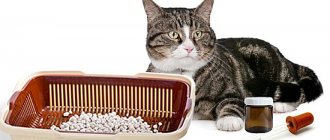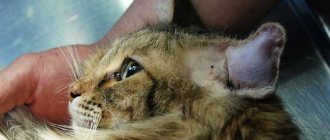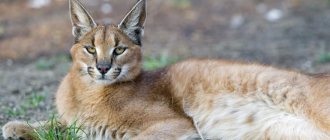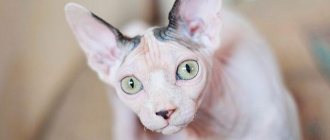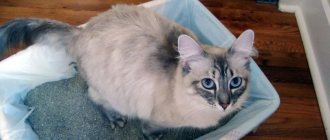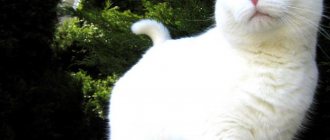Owners should definitely make a “bed” at home. This will prevent damage to decorative indoor flowers and prevent the possibility of poisoning by a harmful plant.
Reasons for temporary vegetarianism
All cats need grass: wild, outdoor, domestic. Becoming a vegetarian for a while is instinctive and natural.
It is not known exactly why cats eat grass, but there are several versions:
- the herb is a natural means of cleansing and stimulating the intestines, fighting parasites;
- the grass curls up into lumps along with the hair and is excreted by regurgitation or through the intestines;
- greens contain minerals, B vitamins, folic acid, which are not found in meat; cats know instinctively which greens are needed at a particular moment;
- some herbs contain substances that act as pain relievers on animals;
- sometimes cats just like the taste of greens.
You should not prohibit your domestic cat from eating grass while walking.
It is necessary because it helps improve health and prolong life. There is an opinion that greens help against obesity if the cat is sterilized (neutered). The situation is different with indoor flowers.
Cats are not always able to determine which ones are likely to cause harm. Therefore, before planting new flowers on the windowsills, it is advisable to find out whether the cat can be poisoned by their leaves. If there are such indoor plants (dracaena, ficus, ivy, begonia), it is important to exclude the possibility of access.
Why do cats eat grass?
Scientists have identified several main reasons why cats need to eat grass:
- Vitamins and microelements. Cats are able to bite the tops of blades of grass; they do this to replenish the body with beneficial folic acid, choline, biotin, phosphorus, magnesium, sulfur, zinc, etc.
- Cleansing the stomach from wool. Grass for cats can provoke vomiting, which causes objects, bones or hairs that the animal has eaten by mistake to come out.
- An alternative to indoor plants.
What greens do cats prefer?
Most often, representatives of the feline species eat creeping wheatgrass on the street. This is a weed that is not hard to find. Cats gnaw only on the juicy ends of the leaves, which contain carotene, fructose, and silicic acid. Dubnitsa and Dubrovka are also useful.
If animals are not taken out for walks, the owners must take care of the grass. Pet stores offer Avena sativa (common oats), but some pets don't like it. At home, wheat, barley, and sedge are most often planted. Almost all cats do not refuse grain sprouts.
You can buy grain at a pet store (oats can also be bought at a pharmacy) and sow it in a container for indoor flowers. Sprouts appear in a few days, and the cat can eat them in a couple of weeks. It is important to remember that cats can be harmed by oat inflorescences.
Some cat owners grow mint or lemon balm, but not every cat will eat them. In addition, these plants have different effects. Some animals calm down, others become activated, which is not always desirable. It is better to limit the consumption of lemon balm and mint. Essential oils in their composition can cause stomach upset.
For domestic cats, you can sow on the windowsill:
- catnip (catnip), containing phytohormones that energize;
- valerian;
- lemongrass
Although cats love valerian, it is difficult to grow it at home due to its large root system. Requires a pot with a volume of 5 liters, it must be placed in a place well lit by the sun.
Schisandra acts as a sedative on cats, cleanses the body, and relieves pain. It is not difficult to grow at home in a wide pot that is difficult to turn over. If vitamins are needed, parsley is planted, rosemary protects against fleas. Any plant must be fresh (held firmly in the ground by its roots), otherwise the animal will not eat it.
You shouldn’t grow all the herbs that cats love at home. Catnip and valerian act like a drug, which negatively affects behavior.
Which seeds to choose
As has already become known, not every grass is suitable for planting. It is best to choose the seeds of oats, wheat, barley and other cereal plants at the pet store. And if you are not sure that this particular herb will help your pet, choose complex preparations, because the market does not stand still and is constantly evolving.
Different cats eat different grass
And yet, what is the best grass to plant for a cat at home? Now we will look at several options that pet stores offer us:
| Name | Compound | Growing methods |
| Alpine meadows 7 herbs | Oats, wheat, rye, barley, millet, sorghum, vetch; | Herbs in a vermiculite-based substrate. The kit comes with a container, pour out the substance, moisten it with water, lay out the seeds, cover the container with a lid. Place in a warm, bright place. The grass grows in approximately 10 days. |
| Horse | Oats, ryegrass, meadow grass; | Seeds can be germinated in any way convenient for you. Approximate growing time is one and a half to two weeks. Grass height 10 cm. |
| Weed for cats TitBit | Oats | This product is very easy to use, as it comes with a container and a padding polyester bag. You just need to pour water on it, cover it with a lid and place it in a warm, lighted place. After 8-10 days, your cat can enjoy fresh grass. |
What indoor flowers can spoil?
Cat people often complain that their pets spoil their indoor flowers. The interest is not always gastronomic. They play with stems, dig in the soil, and turn over pots. Indoor flowers serve as a substitute for grass in winter. They are not always useful, often even poisonous. Cats will not touch flowers if greens are grown for them at home. This is especially important in the city, where the necessary plants cannot be found in the yard.
Ways to preserve indoor flowers:
- place in a place inaccessible to the pet;
- regularly spray with a solution of lemon juice, table vinegar or special sprays;
- place sprouted cereal next to it;
- cover the soil in pots with shells, pebbles, gravel;
- saturate the mulch with an unpleasant odor, cover with a plastic mesh;
- buy special grilles.
These measures will not help completely prevent damage to ornamental plants, but the risk will be reduced.
Following some simple rules also helps:
- plant flowers in hanging pots, on the walls;
- choose heavy containers;
- do not place plants on the windowsill too closely, use stands;
- secure racks and racks.
Ornamental plants can be protected with fences and display cases can be used.
Houseplants for cats
Despite the harmlessness and beauty of some plants for humans, for a cat it can be real poison. Not all herbs can be given to pets; many of its varieties can poison the animal.
Maybe this is your indoor flower? These beautiful flowers can kill your pet, so keep a close eye on them.
Plants that are poisonous to cats:
- ivy;
- Decembrist;
- azaleas;
- begonia;
- dracaena;
- ficus;
- monstera.
How to make a “bed” in an apartment
Most often, grass seeds are purchased at pet stores and planted in a ready-made substrate, self-prepared soil mixture, or vermiculite.
Sequencing:
- soak the seeds for about three hours;
- pour soil into a pot or container for decorative indoor plants (2/3 of the volume);
- lay out the seed, cover with soil (2-3 cm);
- pour, cover with film.
The film is removed after seed germination. The sprouts are suitable for food after 2 weeks. To avoid a break, sowing is carried out every 3 weeks.
Some cat owners prefer to grow grass in plastic dishes. The bottom of a container with a smaller diameter is pierced in several places, cotton wool is laid out, moistened with water, seeds are poured in, and covered with gauze with large cells. A small plate is placed in a large one and covered with film.
Supplementing a cat's diet with grass is not necessary, but it is correct. It is useful if you use the one intended for pets. This is an additional source of minerals and vitamins that helps stabilize the functioning of the stomach and intestines. The home version is even better than the street version, since there is no risk of eating grass with parasites.
Which grass is sweeter
What grass do cats prefer? This is usually Avena sativa or common oat. It is most often sold in pet stores. Oats are quite easy to grow at home. You just have to take into account that its inflorescences are harmful to cats, although the likelihood that the cat will not understand and eat them is very small.
Sometimes owners buy or specially grow mint for their pets. The love for its stems is matched only by the love for its aroma, but it is worth noting that not all cats are inclined to eat mint, and not all become “drunk” good-natured people after it. Some, on the contrary, are too “active” and start running. But not all cats eat store-bought grass; some prefer to wait until they go to the country and find the necessary greens on their own.
So what kind of grass do cats eat outside? After all, sprouted oats are hardly available to most walking purrs.
How to grow cat grass at home
You can purchase a ready-made miniature lawn for your mustachioed pet at almost every pet store. These are relatively small financial costs. But a cat is an unpredictable creature, and may refuse a green gift if it doesn’t like something. Try providing your pet with a vitamin supplement by building a garden bed right on the windowsill.
Seed selection
Large grains of cereal crops are convenient for sowing grass indoors. They are usually sold already packaged in packages of 10–100 grams. The most popular is oats, but some producers include wheat and barley in the harvest for sowing.
To grow shoots of field grasses, you need to collect their seeds yourself at the end of summer. Ready-made lawn grain mixtures are treated with growth stimulants and fertilizers, so they should not be given to cats . In addition, such plants germinate and develop poorly in winter, when the length of daylight hours is reduced.
Criteria for purchasing seed:
- Buy from a reliable supplier who values its reputation. Otherwise, you risk getting a bag of old grain. Due to low germination, there will be few sprouts. Look at the expiration date indicated on the packaging.
- Ask the seller if the seeds have been treated with chemicals, and also check for fungal infection.
- Decide how many grains you want to plant. It depends on the size of the future lawn. If its dimensions are 20x20 cm, then you will need 30–40 grams of seeds. The same amount is enough for sowing in a seedling tray measuring 38x16 cm. It’s not worth buying more if you have one container occupied.
Planting grass
Before you start growing green food for your cat, you need to prepare a flat dish. Transparent cookie packaging or disposable plates made of food-grade plastic are suitable for this purpose. The height of the sides should not exceed 8 cm. To plant grass, take two containers. Holes are made in the bottom of one of them to drain excess water and placed in the other. It is not advisable to use a flower pot on a stand - the cat will easily knock it over when it starts pulling out the stems.
To secure roots, oat seedlings need any substrate. mixtures for indoor flowers are used as soil . Earth brought from the street is disinfected by heating it at a temperature of +650C to destroy the plant diseases it contains. But you shouldn't plant grass in the soil if your cat likes to dig in it. Then the lush greens and the contents of the mini-garden will be scattered on the floor.
The grains of cultivated cereals contain a supply of nutrients necessary for growth. To get healthy shoots in containers without soil, use any natural material as a substitute. A paper towel, a package of napkins or cotton pads will do. They are environmentally friendly and will not cause harm to your pet’s health if he accidentally eats them. To maintain air access to the surface of the seeds, gauze with a sparse weave of threads is used.
Cereals grow without soil, using nutrition from their own seeds.
Sowing stages:
- To create a “vegetable garden” on the windowsill, choose at least three days in a row of sunny weather to provide the sprouts with more light and warmth.
- The seeds are poured into a glass jar and filled with water for an hour. The floating waste is removed with a spoon. The full grains remaining at the bottom are placed on a napkin.
- In the prepared container, the soil substrate is compacted with a layer of 1.5–2.0 cm, and seeds are placed thickly on top. Level with a spoon. Sprinkle them with a small amount of soil and compact them slightly.
- When sowing without soil, place a layer of cotton wool or paper up to 1 cm thick at the bottom of the container, then wet grains of oats or wheat. They are covered with gauze folded in half.
- Water it with water heated to +250C to stimulate the awakening of the grains. It is advisable not to over-wet the future lawn, otherwise mold will appear.
- Cover the top with plastic wrap or place it in a transparent bag and tie it at the side. Leave a little free space for the sprouts to breathe. Place the dishes in a warm place, closer to the radiator.
Growing
To obtain successful shoots, it is necessary to maintain a room temperature of at least +200C and a humidity of the root zone of 75%. In November and December, the days are very short, so the tray with oats needs additional lighting. To prevent plants without soil from starting to rot and acquiring an unpleasant odor, they are thoroughly washed every day with running water.
Features of growth:
- 48 hours after planting, oats begin to take root. The film is removed and the surface of the soil or gauze is sprayed with water in the morning and evening. A day later, the first light yellow shoots appear. The box is placed on the window under the sun's rays.
- Each plant produces a pair of true leaves. They acquire a green tint already on the fifth day. Water them in the morning and evening so that the roots do not dry out. A hard, thick carpet of seedlings is formed, which bend towards the light. The tray is turned to the window with different sides so that the stems develop evenly.
- The roots of the oats grow and intertwine together, forming a dense lump.
- Less than a week has passed, and the blades of grass have already reached a height of 8–12 cm. Their upper ends are unfolded and contain a maximum of vitamins. It's time to offer your pet treats.
Plant foods help domestic cats clear their stomachs of hair.
Growing green food for your mustachioed pet without using soil is the most convenient option for owners living in apartment buildings. This method allows you to provide the animal with plant food at any time of the year.
Where to buy and how much to pay
To grow grass on a windowsill, just visit any pet store. Also, special sets of seeds for pets can be found in flower shop windows or among agricultural seeds.
The price of grass for cats is cheap. Therefore, it is recommended to buy several sets at once. While the cat is destroying the first pot, the owner will already have time for the next portion of cat greens.
Even if the pet does not eat all the grass, it is recommended to periodically update the vegetation, since old sprouts lose not only their attractiveness in the eyes of the cat, but also their nutritional properties.
